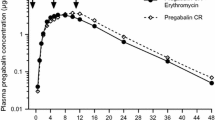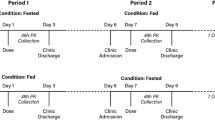Abstract
Background
Pregabalin (Lyrica®) is approved as an immediate-release (IR) formulation for administration twice (BID) or three times (TID) a day depending on indication. Once daily (QD) dosing may be appropriate for ease of clinical use and patient convenience.
Objectives
The objectives of this analysis were: (1) to evaluate the pharmacokinetics of pregabalin controlled-release (CR) administered with food relative to the pregabalin IR formulation administered fasted; (2) to evaluate the pharmacokinetics of a two-tablet dose of pregabalin CR compared with the equivalent one-tablet dose of pregabalin CR; and (3) to determine the safety and tolerability of multiple-dose administration of pregabalin CR and IR.
Methods
The pharmacokinetic properties of pregabalin CR were determined in four phase I, open-label, multiple-dose crossover studies (18–24 participants/study). Pregabalin CR (82.5, 165, 330 or 660 mg/day) administered QD was compared with pregabalin IR (75, 150, 300 or 600 mg/day, respectively) administered either BID or TID. Blood samples were collected up to 24 h post-dose. Pharmacokinetic parameters were estimated from plasma concentration–time data using standard noncompartmental methods. Adverse events were monitored throughout all studies.
Results
Eight-four healthy participants (19–55 years of age) received pregabalin. For all pregabalin CR doses, total exposure was equivalent to the corresponding pregabalin IR dose. Relative bioavailability of pregabalin CR was 93–97 % of pregabalin IR, and bioequivalence criteria with respect to the 24-h steady-state exposure (area under the plasma concentration–time curve from 0 to 24 h [AUC24]) were met. Administration of a two-tablet dose of pregabalin CR was bioequivalent to one-tablet pregabalin CR. The relative bioavailability of two-tablet pregabalin CR was 97–102 % of one-tablet pregabalin CR, and bioequivalence criteria with respect to AUC24 and peak plasma concentrations were met. Pregabalin CR pharmacokinetic parameters were dose proportional following administration of 82.5–660 mg/day pregabalin CR. Pregabalin was well tolerated across studies, with no serious or severe adverse events.
Conclusion
Total daily exposure with multiple-dose pregabalin CR is equivalent to the corresponding pregabalin IR dose.



Similar content being viewed by others
References
Lyrica (pregabalin) [package insert]. New York: Pfizer Inc.; 2013. http://labeling.pfizer.com/ShowLabeling.aspx?id=561. Accessed 18 July 2014.
Lyrica EU product information. Sandwich: Pfizer Limited; 2014. http://www.emea.europa.eu/docs/en_GB/document_library/EPAR_-_Product_Information/human/000546/WC500046602.pdf. Accessed 18 July 2014.
Corrigan BW, Pool WF, Posvar EL, et al. Metabolic disposition of pregabalin in healthy volunteers [abstract PI-68]. Clin Pharmacol Ther. 2001;69:P18.
Bockbrader HN, Radulovic LL, Posvar EL, et al. Clinical pharmacokinetics of pregabalin in healthy volunteers. J Clin Pharmacol. 2010;50:941–50.
Randinitis EJ, Posvar EL, Alvey CW, et al. Pharmacokinetics of pregabalin in subjects with various degrees of renal function. J Clin Pharmacol. 2003;43:277–83.
Bockbrader HN, Burger PJ, Corrigan BW, et al. Population pharmacokinetic (PK) analyses of pregabalin (PGB) in adult patients with refractory partial seizures [abstract 1.265]. Epilepsia. 2001;42(Suppl 7):84.
Bockbrader HN, Burger P, Knapp L, Corrigan BW. Population pharmacokinetics of pregabalin in healthy subjects and patients with chronic pain or partial seizures. Epilepsia. 2011;52:248–57.
Shoji S, Suzuki M, Tomono Y, et al. Population pharmacokinetics of pregabalin in healthy subjects and patients with post-herpetic neuralgia or diabetic peripheral neuropathy. Br J Clin Pharmacol. 2011;72:63–76.
Ben-Menachem E. Pregabalin pharmacology and its relevance to clinical practice. Epilepsia. 2004;45(Suppl 6):13–8.
Brodie MJ, Wilson EA, Wesche DL, et al. Pregabalin drug interaction studies: lack of effect on the pharmacokinetics of carbamazepine, phenytoin, lamotrigine, and valproate in patients with partial epilepsy. Epilepsia. 2005;46:1407–13.
Bockbrader HN, Burger P, Knapp L. Pregabalin effect on steady-state pharmacokinetics of carbamazepine, lamotrigine, phenobarbital, phenytoin, topiramate, valproate, and tiagabine. Epilepsia. 2011;52:405–9.
Srivastava K, Arora A, Kataria A, et al. Impact of reducing dosing frequency on adherence to oral therapies: a literature review and meta-analysis. Patient Prefer Adherence. 2013;7:419–34.
Alebic-Kolbah T. Pregabalin: development and validation of an LC-MS/MS method for pediatric studies [abstract TP 542]. J Am Soc Mass Spectrom. 2012;23:109.
Kellow JE, Borody TJ, Phillips SF, et al. Human interdigestive motility: variations in patterns from esophagus to colon. Gastroenterology. 1986;91:386–95.
Kumar D, Wingate D, Ruckebusch Y. Circadian variation in the propagation velocity of the migrating motor complex. Gastroenterology. 1986;91:926–30.
Wilson P, Perdikis G, Hinder RA, et al. Prolonged ambulatory antroduodenal manometry in humans. Am J Gastroenterol. 1994;89:1489–95.
Soffer EE, Thongsawat S, Ellerbroek S. Prolonged ambulatory duodeno-jejunal manometry in humans: normal values and gender effect. Am J Gastroenterol. 1998;93:1318–23.
Beydoun A, Uthman BM, Kugler AR, The Pregabalin 1008-009 Study Group, et al. Safety and efficacy of two pregabalin regimens for add-on treatment of partial epilepsy. Neurology. 2005;64:475–80.
Pohl RB, Feltner DE, Fieve RR, Pande AC. Efficacy of pregabalin in the treatment of generalized anxiety disorder: double-blind, placebo-controlled comparison of BID versus TID dosing. J Clin Psychopharmacol. 2005;25:151–8.
Freeman R, Durso-Decruz E, Emir B. Efficacy, safety, and tolerability of pregabalin treatment for painful diabetic peripheral neuropathy: findings from seven randomized, controlled trials across a range of doses. Diabetes Care. 2008;31:1448–54.
Frampton JE, Foster RH. Pregabalin: in the treatment of postherpetic neuralgia. Drugs. 2005;65:111–20.
Freynhagen R, Serpell M, Emir B, et al. A comprehensive drug safety evaluation of pregabalin in peripheral neuropathic pain. Pain Pract. 2013;. doi:10.1111/papr.12146.
French J, Brandt C, Friedman D, et al. Adjunctive use of controlled-release pregabalin in adults with treatment-resistant partial seizures: a double-blind, randomized, placebo-controlled trial. Epilepsia. 2014;. doi:10.1111/epi.12690.
Arnold LM, Arsenault P, Huffman C, et al. Once-daily controlled-release pregabalin in the treatment of patients with fibromyalgia: a phase III, double-blind, randomized withdrawal, placebo-controlled study. Curr Med Res Opin. 2014;. doi:10.1185/03007995.2014.928275.
Chew ML, Plotka A, Alvey CW, et al. Pharmacokinetics of Pregabalin Controlled-Released in Healthy Volunteers: Effect of Food in Five Single-Dose, Randomized, Clinical Pharmacology Studies. Clin Drug Investig. 2014;. doi:10.1007/s40261-014-0211-4
Acknowledgments
The studies described in this paper were sponsored by Pfizer Inc, who was involved in the study design; the collection, analysis and interpretation of the data; the writing of the report; and the decision to submit the paper for publication. Medical writing support was provided by Lorna Forse, PhD, of Engage Scientific Solutions and funded by Pfizer Inc.
Conflict of interest
Marci L. Chew, Christine W. Alvey, Anna Plotka, Verne W. Pitman, Tanja Alebic-Kolbah and Joseph M. Scavone are all full-time employees of Pfizer Inc and hold stock in Pfizer Inc. Howard N. Bockbrader was an employee of Pfizer Inc at the time these studies were conducted and holds stock in Pfizer Inc.
Ethical statement
All studies were conducted in compliance with the ethical principles originating in or derived from the Declaration of Helsinki and in compliance with International Conference on Harmonisation Good Clinical Practice guidelines. All participants provided written informed consent before entering each study. The final protocols and informed consent documentation were reviewed and approved by the Erasme Hospital Ethics Committee, Brussels, Belgium, where the studies were conducted.
Author information
Authors and Affiliations
Corresponding author
Rights and permissions
About this article
Cite this article
Chew, M.L., Alvey, C.W., Plotka, A. et al. Pregabalin Controlled-Release Pharmacokinetics in Healthy Volunteers: Analysis of Four Multiple-Dose Randomized Clinical Pharmacology Studies. Clin Drug Investig 34, 627–637 (2014). https://doi.org/10.1007/s40261-014-0221-2
Published:
Issue Date:
DOI: https://doi.org/10.1007/s40261-014-0221-2




